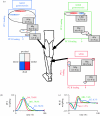The recruitment of different compartments within a muscle depends on the mechanics of the movement
- PMID: 18842570
- PMCID: PMC2657740
- DOI: 10.1098/rsbl.2008.0459
The recruitment of different compartments within a muscle depends on the mechanics of the movement
Abstract
Muscles are commonly assumed to have uniform activations across their bellies. Yet animal studies have shown that different regions across a muscle can vary in their architecture, fibre type, levels of activation and the transfer of forces to the bones and tendons. The purpose of this study was to test whether regional variations in activity occurred across the soleus, medial gastrocnemius and lateral gastrocnemius in man, and whether these regional variations changed with altered mechanical demands on the limb. Arrays of surface electrodes were placed over these muscles and the electromyograms (EMG) measured for a range of cycling tasks where the resistance and pedal velocity was independently altered. Significant variations in the magnitude and timing of the EMG occurred across these muscles, which were most pronounced in the gastrocnemii and occurred in both the proximodistal and mediolateral directions. The patterns of variation across the muscles changed in response to the altered mechanical demands during the cycling. It is likely that the muscle fascicles in the gastrocnemii contribute varied mechanical functions to the contractions that depend on both their location within the muscle belly and on the mechanical requirements of the movement.
Figures


References
-
- Blazevich A.J., Gill N.D., Zhou S. Intra- and intermuscular variation in human quadriceps femoris architecture assessed in vivo. J. Anat. 2006;209:289–310. doi:10.1111/j.1469-7580.2006.00619.x - DOI - PMC - PubMed
-
- Blemker S.S., Pinsky P.M., Delp S.L. A 3D model of muscle reveals the causes of non-uniform strains in the biceps brachii. J. Biomech. 2005;38:657–665. doi:10.1016/j.jbiomech.2004.04.009 - DOI - PubMed
-
- Carrasco D.J., Lawrence J., III, English A.W. Neuromuscular compartments of cat lateral gastrocnemius produce different torques about the ankle joint. Motor Control. 1999;3:436–446. - PubMed
-
- Chanaud C.M., Pratt C.A., Loeb G.E. Functionally complex muscles of the cat hindlimb II. Mechanical and architectural heterogeneity within the biceps femoris. Exp. Brain Res. 1991;85:257–270. doi:10.1016/S0079-6123(08)62684-9 - DOI - PubMed
-
- DeLuca C.J. The use of surface electromyography in biomechanics. J. Appl. Biomech. 1997;13:135–136.
Publication types
MeSH terms
LinkOut - more resources
Full Text Sources
